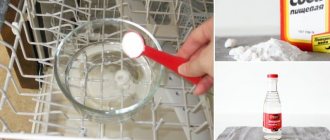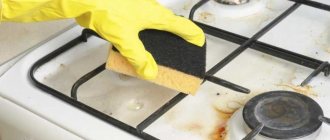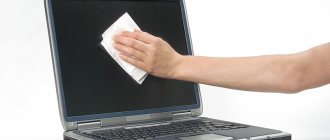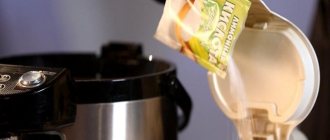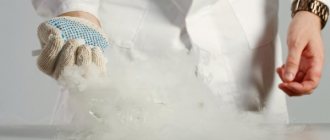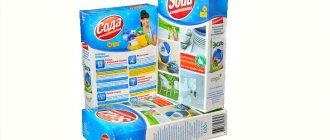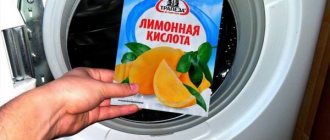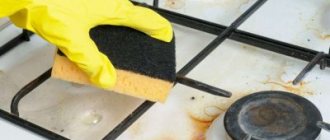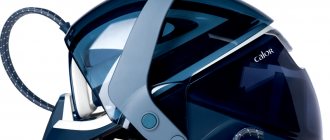Burning of fabric to the soleplate of the iron occurs quite often. Owners of even the latest modern models of irons are not immune to this problem. Most often, trouble occurs as a result of incorrect temperature adjustment. There are many ways to clean the device. The procedure can be carried out using folk recipes or ready-made store products. But to get the most effective results, you need to know the general rules for cleaning the soleplate of any type of iron.
General cleaning rules
When removing contamination, you should choose methods that are suitable for a specific iron model. However, there are general recommendations for performing the procedure.
Whatever material the sole is made of, you should remember that cleaning it with metal and sharp objects is strictly prohibited. For example, scissors or hard brushes. You cannot use sandpaper either. Otherwise, scratches will form on the surface of the sole, which will subsequently be impossible to get rid of.
If the procedure is carried out using a chemical agent, after completion it is necessary to wipe the device with a damp cloth. If you do not wipe off any remaining cleaning product in a timely manner, there is a risk of damaging your clothes during subsequent ironing.
It is better to clean the surface on the balcony or in a room with open windows. When using chemicals, you must wear a special mask.
If there are fragments of stuck fabric on the surface, you need to remove them with a cotton swab dipped in vinegar.
Cleaning irons with Teflon and ceramic coatings
Teflon and ceramic coatings are made for modern iron models. The rules for cleaning such coatings are approximately the same. Irons with Teflon coating are good because they heat up to maximum temperature in a short time, and also glide smoothly over the surface of the fabric when ironing. However, such devices require regular maintenance. Otherwise, the device ceases to perform its functions efficiently.
The Teflon sole can be cleaned using chemicals or folk recipes. Most often used:
- Special pencils that help soften plaque.
- Store-bought cleaning products.
- Vinegar.
- Wax.
- Hydrogen peroxide.
Mandatory rule: wipe the surface with a rag or napkin at the end of the procedure.
Expert opinion
Sofia Kovalevskaya
Experienced housewife.
Ask me a question
Ceramic soles can be easily cleaned at home, but also require careful use and proper care. For ceramic surfaces, special glass ceramic cleaning products, sold in specialized stores, are suitable. The procedure is performed using a sponge suitable for non-stick bases.
For home cleaning, use:
- Lemon acid.
- Ammonia.
- Vinegar.
During procedures, it is recommended to carefully walk over the surface to prevent scratches.
Recipes and methods for cleaning an iron from carbon deposits and stuck fabric at home
Acetone
This product very effectively cleans the ironing surface of scale. The processing is very simple.
- There is no need to heat the device before cleaning with acetone. Due to the strong odor of this product, it is recommended to open the windows first.
- A small piece of cotton cloth should be soaked in acetone and the soleplate of the iron should be thoroughly wiped. All dirt will remain on the fabric.
- Upon completion of the procedure, the ironing surface must be wiped with a damp piece of cloth.
An excellent way to clean your iron at home from stuck fabric and carbon deposits.
Liquid soap, shower gel
These products can be used not only for bathing, but also for cleaning the surface of electrical appliances from burnt marks and scale. You can use shower gel or soap only for minor stains.
- Before you start cleaning, you need to turn on the iron.
- After it warms up a little, turn it off.
- A foam sponge is suitable for cleaning. Apply a little product to it and wipe away any dirt from the soleplate of the iron.
- After completing the procedure, the surface must be washed and then wiped dry.
Baby cream
Baby cream is great for cleaning the iron at home from stuck fabric and cleaning the ironing surface of the device from scale. It can be used for irons with different coatings, including Teflon.
- First you need to warm up the iron thoroughly and unplug it before starting the procedure.
- It is better to use a cotton pad for cleaning. You need to squeeze a small amount of baby cream onto it. After the device has cooled down a little, we begin to carefully wipe off the carbon deposits.
- Cotton swabs are great for cleaning steam vents.
- After finishing cleaning, the surface should be washed with clean water and dried thoroughly.
Go to the Land of Advice home page for more interesting stories.
Toothpaste
Every home has toothpaste. This is the most affordable product that helps you quickly clean the soleplate of your iron from stuck fabric. Toothpaste contains many abrasives. In this regard, it is not recommended to use it often for this purpose. Otherwise, scratches may occur on the surface.
- The iron needs to be heated up a little and turned off.
- Apply toothpaste to the base of the device and scrub off dirt with a brush. You can take an old toothbrush that is no longer used.
- Using a foam sponge or rag, you need to thoroughly wash the surface, and then wipe it dry with dry cloths.
- In just a couple of hours the iron will be ready to use.
Dentifrice
This product is used not only to maintain oral hygiene, but also to solve various household problems, for example, if you don’t know how to clean the iron at home from stuck fabric and scale. You need to be very careful when cleaning the Teflon coating of your iron with tooth powder.
- There is no need to heat the device before cleaning.
- It is recommended to use a foam sponge or a waste brush.
- Apply a little product to the coating and begin to carefully remove the dirt with a damp brush or sponge. This must be done until the coating is perfectly clean.
- Remove the remaining powder with a damp cloth.
- Then wash the sole with clean water and wipe dry with a paper towel.
- It is not recommended to use the device immediately after cleaning. You need to wait a bit until it dries.
Soda (caustic, ash)
Everyone knows the excellent cleaning properties of soda. However, you need to be extra careful when cleaning the Teflon soleplate of your iron.
- There is no need to heat the device before starting the procedure.
- Pour 2 teaspoons of baking soda into a small bowl and dilute it with a small amount of water. Stir until smooth.
- Place the iron in the solution with the ironing surface down. It is important that the liquid level does not exceed the level of the sole. The device should remain in this position for 15-20 minutes.
- Then use a sponge to carefully remove the burnt residue and wash the surface. After this, be sure to wipe the sole of the device with a dry piece of cloth.
Cotton fabric
This method is used if the fabric sticks to the sole during ironing. Of course, a thing damaged in this way can no longer be repaired. However, the iron can be saved. Burnt fabric stuck to the soleplate of the iron will prevent you from ironing other items.
- The iron needs to be heated well and turned off.
- Next, soak a piece of cotton cloth in cold water and apply it to the burnt area.
- Thanks to the temperature difference, the burnt fabric will quickly lag behind the ironing surface of the device.
- After the procedure, other contaminants may remain on the sole. To eliminate them, it is worth using other cleaning methods.
An effective way to clean your iron at home from stuck fabric and carbon deposits.
Lemon acid
This product perfectly cleans minor stains. Citric acid is also used to prevent plaque and burns from stuck fabric.
The cleaning solution is prepared from citric acid and water.
- You will need 1 packet of acid and 1 liter of cold water.
- After mixing, pour the solution into a bottle. You can use it every time after ironing.
- There is no need to heat the appliance.
- For cleaning you will need a soft piece of cloth.
- It is moistened in the solution and the sole of the iron is wiped.
The plaque should remain on the fabric. Regular use of this product will help avoid contamination. The home assistant will always be in order.
Heat
There are times when a piece of synthetic fabric sticks to the ironing surface. It becomes impossible to use a damaged iron. However, there is a simple method to save the device.
- The iron must be turned on to maximum. At this temperature, synthetic fabric will simply melt on the work surface.
- After this, it can be easily removed.
- Next, place the unnecessary piece of cotton on the ironing board, having previously folded it into 2 layers.
- The fabric should hang over the edges of the ironing board.
- Iron this fabric so that the burnt material is “scraped off”.
The burnt material will stick to the fabric. After this procedure, there may still be small areas with burnt marks and scale. To remove them, you need to take a wooden spatula or cleaning agent. All this is done with the iron already turned off.
Top 6 Crazy Things Nature Does on a Huge Scale
Chalk
This method cleans the Teflon-coated soleplate well.
- You need to take a small piece of chalk and knead it. You should get a homogeneous powder without lumps.
- Heat the iron to medium temperature and unplug it.
- Sprinkle a little powder on the burnt area.
- Rub the problem areas with a soft cloth.
Contaminants will come off the work surface along with the chalk.
Then the sole of the electrical appliance must be wiped well with a dry paper towel. There should be no chalk or residue left on the surface. Then wipe again with a damp cloth. Wait until it dries.
Ammonia
An equally effective means for cleaning burnt marks is ammonia.
- Before starting the procedure, the device must be warmed up. Do not turn off.
- You will need a small piece of fabric (preferably cotton).
- Soak a rag in the solution and twist it thoroughly.
- Next, put it on the ironing board and iron it with a heated iron.
- All the burn will remain on the fabric.
You need to repeat the procedure until the soleplate of the iron is completely clean. Then turn off the parting and wait until it cools down. Use a damp cloth to remove any remaining dirt from the work surface. The iron will be like new.
Paraffin candle
The problem can be solved using a regular paraffin candle.
- The iron needs to be warmed up well. Before starting the procedure, disconnect from the network.
- Wrap a paraffin candle in a piece of cotton cloth and wipe the carbon deposits well on the working surface of the iron. The device should be held at an angle.
- In contact with the hot sole, the paraffin will begin to melt. The burnt material will flow down with it.
It is important to place some kind of cloth under the iron. When using this method, you need to be careful, because melted paraffin can get on your hands and burn them. You also need to make sure that it does not get into the steam holes.
- After completing the procedure, remove the remaining paraffin with a dry cloth.
- Then wipe with a damp cloth, and again with a dry one.
Shaving foam
If there is minor dirt on the device, you can use shaving foam.
- The appliance must be cold.
- Apply a little foam to the work surface and wait about 20 minutes.
- Use a sponge to remove foam along with dirt.
- Wash the soleplate of the iron and dry thoroughly.
Try this method if you don’t know how to clean your iron at home from stuck fabric and scale.
Hydrogen peroxide
This affordable product does a great job of removing minor burns.
- There is no need to heat the device.
- For cleaning you will need a cotton pad.
- It needs to be moistened in the solution and the sole of the device thoroughly wiped.
- All plaque will remain on the disk.
Cotton swabs work well to clean the steam vents.
After finishing cleaning, you need to thoroughly wipe the soleplate of the iron with a damp cloth and a piece of cloth. After just 1.5 hours the device can be used for its intended purpose. It will glide easily over the fabric, and the work surface will shine like new.
Soda, vinegar and citric acid (solution)
A solution must be prepared from these ingredients.
- To do this you need to prepare a small container.
- Put 2 tbsp in it. l. soda, 2 tbsp. l. citric acid and 1 tbsp. l. vinegar and stir it all.
- The device is not heated before starting the procedure.
- Moisten a small piece of cloth in the prepared solution.
- Place a plastic bag and spread a dampened cloth over it.
- Place the device with the working surface down on a wet cloth and leave for 60 minutes.
- After this time, the burnt material will soften.
- Use a foam sponge to remove dirt from the soleplate of the iron.
- Steam holes should be cleaned with cotton swabs or toothpicks.
- Wash the clean iron with water and wipe with a dry cloth.
Vinegar and soda (solution)
Almost any stain can be removed with a solution of vinegar and soda. Its use is especially important for cleaning the soleplate of the iron from plaque and all kinds of scale.
- You will need a small bowl. You need to put 2 tsp in it. soda and a little vinegar (9%).
- The ingredients must be mixed thoroughly.
- The appliance must be cold.
- You can use a rag or cotton pad to apply the solution.
- Apply the product to the soleplate of the iron.
- Dirty places need to be rubbed thoroughly, then they will come away from the sole.
After completing cleaning, you need to remove dirt and remaining solution with a rag. Next, wash the work surface well with water and wipe dry with a paper towel. A time-tested method to clean your iron at home from stuck fabric and all kinds of carbon deposits.
Water and vinegar
This solution is perfect for preventive purposes. They can also remove accumulated plaque on the working surface of the iron.
- Before starting the procedure, the device must be thoroughly warmed up.
- Pour equal amounts of vinegar and cold water into a small bowl.
- A piece of cotton fabric should be soaked in the prepared solution, squeezed out and spread on an ironing board.
- Iron the fabric with a hot iron.
- All the carbon deposits will remain on the rag.
Remaining plaque can be removed with a cotton pad soaked in the solution. When performing these actions, you need to turn off the iron.
After completing the procedure, the working surface of the electrical appliance must be wiped with a damp piece of cloth and dried.
Soda
Almost any dirt and scale can be removed using a universal remedy - soda. However, soda has one drawback. It can leave microscopic damage in the form of scratches on the surface. In this regard, it is not recommended to use this product to clean the working surface of the iron.
If there are no other means at hand, then you need to use soda carefully.
- Take a soft cloth and a handful of baking soda.
- Dissolve the powder in a small amount of cold water.
- The electrical appliance must be cold.
- Apply the mixture to the sole and leave for half an hour.
- After this time, remove the soda and carbon deposits using a foam sponge.
- Next, wipe the surface with a damp cloth and leave to dry.
Detergent and baking soda
Contamination on the base of the device can be eliminated with any detergent and baking soda. The electrical appliance must be cold.
- You will need a medium sized bowl.
- Mix a little detergent in a container with baking soda. The consistency should be like a paste.
- The prepared mixture must be applied to the sole of the device and wait 30 minutes.
- During this time, the paste will make the soot softer.
- You can remove the cleaning composition with a foam sponge or rag.
- It is important to wash the surface after finishing cleaning and wipe it with a dry cloth.
After such cleaning, the device will work like new.
Lemon juice and ammonia
This solution can even be used for electrical appliances with Teflon soles.
- You need to prepare a lemon and a small container.
- Squeeze out the juice and add 1 tsp to it. ammonia. Mix well. The electrical appliance must be cold.
- We soak a piece of cotton wool in the solution and apply it to the surface.
- Cleaning must be done extremely carefully.
If there is old dirt on the surface of the device, then you need to take a small piece of cloth, dip it in the solution, twist it and spread it on the board. Place the electrical appliance on this fabric. This way the carbon deposits will come off much better and faster.
After completing all the steps, you need to wash the surface with clean water and dry with paper towels. After just 30 minutes the device can be used. One of the best ways to clean your iron at home from stuck fabric and carbon deposits.
Cleaning with fine salt (hot method)
Fine salt perfectly cleans the working surface of the iron from plaque and scale stains. This method cannot be used on Teflon surfaces.
- You will need a newspaper. You need to pour a small amount of salt on it.
- Warm up the electrical appliance well.
- Use a heated device to iron the salt.
- After a few minutes, you can notice that the plane is clearing. At the same time, grains of salt become brown.
- These steps must be repeated until the working surface of the device is completely clean.
- Spoiled salt should be thrown away. Wipe the surface of the device with a damp cloth.
You can use the iron only after it has completely dried.
Cleaning with fine salt (cold method)
In addition to the hot method, there is also a cold method of cleaning the coating. It is better not to use it on Teflon coatings.
- It is not recommended to heat the iron.
- All you need is a damp cloth and a handful of salt.
- Sprinkle fine salt onto the burnt areas and carefully clean them with a damp piece of cloth.
- We remove the remaining carbon deposits and salt with a foam sponge.
- Then you need to wash the surface with water and wipe with a dry towel.
- After drying, the device is ready for use.
Voice mutation in boys
A piece of gauze and kitchen salt
This is a fairly simple method of cleaning the surface from dirt. However, this method is not suitable for Teflon soles.
- To perform the procedure, you will need a piece of gauze and a handful of table salt.
- We fold the gauze in several layers. Place the salt in the middle of the rectangle and tie a knot.
- Heat the device plugged in to a high temperature. Before starting cleaning, turn off the device.
- With a knot tied with salt inside, you need to carefully rub the plaque onto the surface. After cleaning the sole, carbon deposits can only be seen on a piece of gauze.
- After completing the procedure, the working surface of the iron must be wiped with a clean cloth.
Special means
Today, the market offers a wide range of special products for cleaning the house. Among them are those that are specially designed for cleaning the iron:
- “Magic Power” is a preparation for cleaning Teflon coatings. The product effectively removes carbon deposits and is easily washed off with plain water.
- “Top House” – cleans the surface of the iron as carefully and efficiently as possible.
- “Topperr” is a completely non-toxic drug. Removes even stubborn dirt such as old burnt marks.
Matchbox
Some people don’t know that you can descale your iron with a regular box of matches. This method is only suitable for stainless steel surfaces.
For the procedure you will need a new box of matches. Its sides should not be erased.
- The electrical appliance must be connected to the network and wait until it warms up.
- Next, turn off the device.
- Use the rough side of the box to carefully clean the base of the device.
- Actions must be taken as carefully as possible. This will help avoid scratches.
- After finishing cleaning, take a cotton swab or piece of cloth and remove the remaining carbon deposits.
A simple but very effective method to clean your iron at home from stuck fabric.
"Sif Anti-Fat"
Modern household chemical stores offer a huge selection of kitchen cleaning products. "Sif Anti-Fat" is sold in the form of a spray. It will help keep the kitchen clean, as well as remove carbon deposits from the iron.
- There is no need to preheat the device.
- The spray is quite easy to use.
- Spray a little spray on the dirty sole and wait about 15 minutes.
- Then use a foam sponge to remove the cleaning agent along with the dirt.
- Wash the surface thoroughly with a piece of cloth and dry it.
Window cleaner
This product will solve the problem of a dirty iron. It is not recommended to heat the device. For minor stains, you can simply moisten a small piece of cloth in the product and wipe the surface thoroughly.
- In a situation where fabric is stuck to the working surface, you need to spray the product on the sole.
- Next, soak a piece of cotton wool in nail polish remover and clean the problem area.
- It is important that this product does not contain acetone.
- Then spray the product on the surface again and wipe it with a cloth.
- Next, wipe with a damp piece of cloth and a paper towel.
Dishwashing liquid
This product is available in every kitchen. It can be used not only for washing dirty dishes, but also for eliminating dirt on the iron.
Old stains will be difficult to remove using this method. However, the product removes fresh plaque quite well.
- Take a foam sponge and apply a little product to it.
- The problem area needs to be rubbed thoroughly.
- If there is no positive result, it is recommended to place the sponge on the burner and wait a while.
- If necessary, repeat the procedure several more times.
When the surface becomes clean, it should be washed with water and then wiped dry with a dry cloth. After just a couple of hours you can start ironing.
A mixture of baking soda and dish soap
It is not recommended to clean irons with Teflon-coated soles with this product.
- You need to start the procedure with a cold electrical appliance.
- The cleaning solution is prepared from baking soda and dishwashing detergent.
- For this you will need a small basin or bowl.
- Pour dish soap into a container and add 1 tsp to it. soda
- Mix thoroughly.
- You can apply the solution with a foam sponge. We wait about 5 minutes.
- Then use a clean sponge or rag to carefully remove the product along with the plaque.
Next, the surface needs to be washed and dried with a towel. After just 60 minutes you can iron with an electrical appliance. The advantage of this method is that all the ingredients to clean the iron at home from stuck fabric are always at hand.
Nail polish remover
There are cases when particles of polyethylene accidentally stick to the working plane of the device. In such a situation, this particular remedy will help.
- It is not recommended to heat the appliance before cleaning.
- A small piece of cotton wool should be moistened with nail polish remover and wipe off the burnt elements.
- If necessary, a soaked cotton wool can be applied to the problem area and wait about 3 minutes.
This procedure will help the polyethylene quickly peel off from the surface. The remaining elements can be easily removed with a damp piece of cloth. Finally dry with a dry towel.
Preparations for cleaning microwaves and glass ceramics
This method is ideal for cleaning electrical appliances with ceramic surfaces.
- To perform the procedure, you will need a container with the product, a washcloth and some kind of tray (you can put a regular plastic bag on it). The electrical appliance does not heat up.
- A washcloth is soaked in a cleaning product and applied to the contaminated areas.
- A certain amount of cleaning product must be poured onto a plastic bag. Place the iron with the working surface down directly into the puddle.
- Leave the device in this state for half an hour.
- After the time has passed, remove the drug along with the dirt. To do this, you can take a washcloth or rag.
- Wipe the now clean soleplate of the iron with a damp cloth. The iron must dry thoroughly.
Now you can safely start ironing things.
Table vinegar
This method will help with minor stains in the form of scale. The iron must be cold and unplugged. It is recommended to first ensure that the room is ventilated, as well as wear protective gloves.
- To perform the procedure, you will need cotton wool (cotton pads) or a small piece of fabric.
- We moisten it in table vinegar (9%) and actively wipe the contaminated surface.
- When it becomes clean, you need to wipe it with a damp cloth or napkin.
You should not use an electrical appliance immediately after the cleansing procedure. You need to wait until it dries. This will happen in about 2 hours. Vinegar is found in every home and, if anything happens, it will help clean the iron at home from stuck fabric and carbon deposits.
"Hydroperit" tablets
Many housewives clean dirt on the iron with Hydroperit tablets. Before starting the procedure, you need to ensure the room is ventilated. This is due to the fact that the drug has an unpleasant odor.
- Before cleaning, the iron must be heated well and then unplugged from the outlet.
- Use a tablet to gently wipe the hot base of the electrical appliance.
- Then you need to wait until the iron cools down completely.
- Use a damp cloth to remove any remaining tablets along with any dirt.
- After this, wipe the working surface of the device dry.
Teflon scraper
This method is effective after problematic ironing, when the fabric has stuck to the surface of the device. A Teflon scraper works great for this problem. The device is sold in every hardware store. If you don't have a scraper, you can use a wooden kitchen spatula.
- You need to turn on the iron and wait until it heats up. Then unplug it.
- You need to scrape off the burnt elements of the fabric very carefully so that there are no scratches left on the sole.
- After such cleaning, other contaminants may remain. To eliminate them, you can use other means.
- Finally, you need to wipe the surface with a damp cloth and wait until it is completely dry.
After just 2 hours you can safely start ironing things.
Ammonia and vinegar
This method is excellent for significant stains in the form of burnt marks. It is not recommended to heat the device.
- You will need a small bowl in which to mix ammonia and vinegar. The proportions should be equal.
- Dampen a washcloth or rag in the solution and vigorously wipe the dirty sole. You can place a rag soaked in the product on the work surface and leave it there for half an hour.
- After such actions, the carbon deposits will come off easily.
A perfectly clean iron should be washed with water and allowed to dry.
Foil
A good solution to solve this problem is foil.
- The device must be connected to the mains. Heat to maximum temperature. First you need to buy a large piece of foil. It shouldn't be too thin.
- Spread the material on the ironing board, take a hot iron and start ironing. All actions are performed in the same way as during normal ironing.
- After about 5 minutes, you will see that carbon deposits from the surface of the iron are transferred to the foil. Such actions must be carried out until the device is completely cleaned. Dirty material should be thrown away.
How are tomatoes harmful to the body?
A perfectly clean device will continue to delight you.
Self-cleaning function
Today, household appliance stores offer a huge range of irons. Expensive models are equipped with various functions. Cheap models usually have a standard set of features.
Before using the iron, you should carefully read the instructions. Some modern models are equipped with an additional self-cleaning function. Maybe your device also has this function. By taking advantage of this opportunity, you can clean the steam holes well.
It is worth noting that this function is powerless if the fabric sticks to the sole, as well as if there are old contaminants.
However, if you use this option after each use of the device, you can avoid many problems associated with plaque and contamination of the working surface of the iron.
Laundry soap
Everyone knows the cleansing capabilities of laundry soap. This product is accessible and has maximum effect in cleaning dirt and any type of scale on the working surface of an electrical appliance. However, with old soot, this remedy is powerless.
- The iron must first be plugged in and heated to the minimum temperature.
- Moisten laundry soap with water and rub the soleplate of the iron. The device should remain in this state until it cools down completely.
- Using a damp sponge, remove the remaining soap along with softened carbon deposits. Place a damp piece of fabric on the ironing board and iron it. This will help remove soap residue and eliminate streaks.
If you don't have laundry soap, you can use standard toilet or liquid soap.
Dish cleaning powder
This method is suitable for minor stains. On Teflon coatings, you need to apply the powder as carefully as possible.
- We do not heat the iron. Pour a little powder onto a damp washcloth and carefully wipe the problem areas.
- Remove any remaining product with a damp cloth. Next, wash the surface with water and dry.
- In about an hour and a half, the iron will be ready for use.
Cleaning irons with metal coating
Rules for cleaning metal coatings depend on the specific material. Metal bases are made of steel and aluminum. The steel surface is good because it has sufficient strength and good glide over the fabric. In addition, it is easy to clean. Common means to combat carbon deposits on steel soles:
- Soda.
- Toothpaste.
- Lemon acid.
The easiest option is to use laundry soap; this method was used back in the last century. However, soap can clog the special holes, making it difficult to release steam. You can also get rid of carbon deposits using a wooden spatula, however, you must ensure that scratches do not form on the coating.
Irons with aluminum soles are known as the most inexpensive devices. But the price usually corresponds to the quality, and careful and regular maintenance is required to keep such an iron performing well. Aluminum soles are unstable and brittle; they quickly become scratched and most often develop carbon deposits. To clean the aluminum surface, the use of hard brushes and sponges is not allowed. It is possible to remove stains using special pencils, soda or vinegar.
Important! It is forbidden to use citric acid on aluminum, otherwise the metal surface will likely be destroyed.
How to clean the soleplate of an iron from old plaque
Only drastic measures can cope with old plaque, but it is worth understanding that overly radical methods are not acceptable.
And vinegar again: a less scrupulous, but most effective method
Wet a rag in clean table vinegar. We heat up the device, but unlike last time we don’t leave it plugged in, but turn it off after heating. Place the iron with the soleplate on a cloth and leave it for a couple of hours (ideally overnight).
After soaking, you can scrub the iron without any extra effort using a soapy solution and clean water.
Before starting work, open the windows to ensure good air circulation. Vinegar fumes are harmful to health.
Toothpaste is an assistant in the fight not only against plaque
Regular toothpaste will help clean the iron from old plaque.
To be effective, the paste must be applied to a warm surface. Rubbing is appropriate and even necessary. There will definitely be no scratches or damage. Dirt and carbon deposits will be removed along with the remaining toothpaste.
Toothpaste is an excellent cleaner. It is soft and effective. But the areas of the steam outlets should be wiped carefully so that they do not become clogged.
Dissolve old plaque with citric acid
Citric acid is truly a wonderful remedy that works effectively even with old scale.
We perform the following steps:
- Pour a liter of boiling water into a flat container.
- Dilute 5 tbsp in it. l. acids.
- Immerse the iron in the mixture so that the soleplate is just in contact with the liquid, but not completely immersed in it.
- Leave for a couple of hours.
- Wash off the carbon deposits with a soft cloth.
Watch the iron carefully so that nothing except the soleplate comes into contact with the water.
Popular ways to clean an iron from burnt fabric
Sticky fabric must be removed from the surface using a method depending on the coating of the iron. Today, on the shelves of hardware stores there are many products suitable for cleaning any surface. The most budget option is special pencils or crayons. Homemade products are equally common, such as vinegar, soda, citric acid or toothpaste.
Special pencils and tools
Cleaning sticks are considered a universal tool and are suitable for cleaning surfaces made of any materials, especially if there is stuck fabric. In addition, pencils are attractive due to their cost. The average price of a product is 50 rubles, but the amount may vary depending on the manufacturer’s brand. You can buy a pencil in hardware stores or online.
The good thing about the product is that it does not contain abrasives, which makes it unlikely that scratches and cracks will appear on the sole. Some pencils can not only remove elements of burnt fabric, but also remove scale from the surface. One of the disadvantages is the unpleasant odor of the product, which intensifies during the cleaning process. Therefore, it is recommended to open the windows during the procedure. To achieve the desired result, you need:
- Preheat the iron to its highest temperature.
- Slightly tilt the device and walk the pencil over the contaminated areas. The cleaning element will begin to melt and flow down. At this moment, you should take safety precautions, otherwise a burn may occur. You don't need to press hard on the pencil.
- Wait until the iron cools down; to do this, you can take it out onto the balcony.
- Remove any particles of product with a cloth or napkin.
- Before using the device, it is recommended to first walk on the cotton surface.
If the deposit has not completely disappeared, it is recommended to repeat the procedure again.
To clean ceramic soles, you can use special products for glass ceramics. For the procedure, you will need to warm up the iron, apply the product to the sole, wait a little, and wash off the residue with a rag or napkin.
Home methods
You can remove carbon deposits from the soleplate of an iron with many household products that are available in the arsenal of almost any housewife. The most common options are hydrogen peroxide, citric acid, soda, and salt.
To perform the procedure using peroxide, you need:
- Take a cotton pad and soak it generously in peroxide.
- Wipe the soleplate of the iron.
- Wipe off any residue with a damp cloth.
There is no need to heat the iron during the process.
Cleaning with citric acid gives an effective result that is no different from store-bought products. To complete the procedure, you should follow the instructions:
- Add a spoonful of citric acid to a glass of cold water.
- Stir the solution.
- Pour it into a special liquid reservoir.
- Activate the steam release function.
- Repeat the steps several times.
Next, let the iron cool and wipe the soleplate with a cloth.
To remove carbon deposits using baking soda you will need:
- Heat the device to the highest temperature.
- Wrap a few spoons of soda in a bandage or gauze.
- Go through problem areas.
When finished, let the iron cool and wipe the soleplate with a rag or napkin.
To carry out the procedure using salt, you will need:
- Spread a cotton cloth on a hard surface.
- Pour a glass of salt onto it.
- Heat the iron and walk over the cloth with salt.
- Continue until the salt turns brown.
Allow the iron to cool and wipe the cleaned area with a cloth.
Methods for cleaning an iron from carbon deposits
It is not difficult to keep the surface of the sole in perfect condition if you carefully follow the recommendations for ironing items made from natural and synthetic fibers. The safe temperature is indicated on the clothing label and bedding packaging. But what if an accidental violation of the recommended temperature conditions caused the fabric to burn?
Cleaning the iron from burning can be done either with special chemicals purchased at a hardware store or with folk remedies. Many simple but effective recipes have been preserved from the times when irons did not have thermostats. Before cleaning the iron from burnt fabric, you need to pay attention to the material from which the soleplate of the device is made.
If a ceramic iron needs cleaning, then the use of abrasive substances and salt is contraindicated: any scratch can lead to peeling of the ceramic. Teflon non-stick soleplates can also be damaged by solid particles contained in the cleaning product. Even the cheapest steel appliance can be rendered unusable if you try to remove dirt with sandpaper, steel wool or a brush. The surface, scratched during inept cleaning, begins to cling to the thin fibers of the fabrics, tears them off, and they become charred, forming the very soot that the housewife is trying to get rid of.
Preventing the formation of burning marks
Problems with carbon deposits can be avoided if you follow some rules and regularly monitor the device. Even modern models of irons with non-stick coatings require careful care.
To eliminate problems you should:
- Carefully select the temperature for a specific fabric material.
- Perform the ironing process only on a stable and hard surface.
- Add clean water that has passed through a filter or boiled into the liquid reservoir.
- Don't forget to throw away any remaining water after ironing.
- After each ironing, wipe the soleplate of the iron with a napkin.
- Clean the device regularly.
- Try to iron synthetic fabrics through gauze.
- If fragments of tissue appear on the sole, remove them with a cotton swab dipped in hydrogen peroxide.
Important! If carbon deposits do form, it is better not to use the iron for ironing, but to clean it thoroughly. Otherwise, the contaminated sole will leave dirty marks on it when it comes into contact with the fabric.
